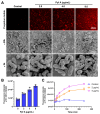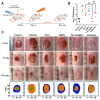Dual Redox Targeting by Pyrroloformamide A and Silver Ions Enhances Antibacterial and Anti-Biofilm Activity Against Carbapenem-Resistant Klebsiella pneumoniae
- PMID: 40723943
- PMCID: PMC12291900
- DOI: 10.3390/antibiotics14070640
Dual Redox Targeting by Pyrroloformamide A and Silver Ions Enhances Antibacterial and Anti-Biofilm Activity Against Carbapenem-Resistant Klebsiella pneumoniae
Abstract
Background: Dithiolopyrrolones (DTPs), such as holomycin and thiolutin, exhibit potent antibacterial activities. DTPs contain a disulfide within a unique bicyclic scaffold, which may chelate metal ions and disrupt metal-dependent cellular processes once the disulfide is reductively transformed to thiols. However, the contribution of the intrinsic redox mechanism of DTPs to their antibacterial activity remains unclear. Herein we used pyrroloformamide (Pyf) A, a DTP with a unique formyl substituent, as a prototype to study the antibacterial potential and mechanism against ESKAPE pathogens, in particular carbapenem-resistant Klebsiella pneumoniae (CRKP). Methods: The antibacterial and anti-biofilm activities of Pyf A were mainly assessed against clinical CRKP isolates. Propidium iodide staining, scanning electron microscopy, glutathione (GSH) quantification, and reactive oxygen species (ROS) analysis were utilized to infer its anti-CRKP mechanism. The synergistic antibacterial effects of Pyf A and AgNO3 were evaluated through checkerboard and time-kill assays, as well as in vivo murine wound and catheter biofilm infection models. Results: Pyf A exhibited broad-spectrum antibacterial activity against ESKAPE pathogens with minimum inhibitory concentrations ranging from 0.25 to 4 μg/mL. It also showed potent anti-biofilm effects against CRKP. Pyf A disrupted the cell membranes of CRKP and markedly depleted intracellular GSH without triggering ROS accumulation. Pyf A and AgNO3 showed synergistic anti-CRKP activities in vitro and in vivo, by disrupting both GSH- and thioredoxin-mediated redox homeostasis. Conclusions: Pyf A acts as a GSH-depleting agent and, when combined with AgNO3, achieves dual-targeted disruption of bacterial thiol redox systems. This dual-targeting strategy enhances antibacterial efficacy of Pyf A and represents a promising therapeutic approach to combat CRKP infections.
Keywords: AgNO3; carbapenem-resistant Klebsiella pneumoniae; glutathione; pyrroloformamide A; redox homeostasis; thioredoxin.
Conflict of interest statement
The authors declare no conflicts of interest.
Figures










Similar articles
-
The antimicrobial peptide Cec4 has therapeutic potential against clinical carbapenem-resistant Klebsiella pneumoniae.Microbiol Spectr. 2025 Jul;13(7):e0273824. doi: 10.1128/spectrum.02738-24. Epub 2025 May 16. Microbiol Spectr. 2025. PMID: 40377314 Free PMC article.
-
Antibacterial efficacy of cefoperazone/sulbactam in combination with various antimicrobials against carbapenem-resistant Klebsiella pneumoniae.Acta Microbiol Immunol Hung. 2025 Apr 23;72(2):106-112. doi: 10.1556/030.2025.02577. Print 2025 Jun 20. Acta Microbiol Immunol Hung. 2025. PMID: 40266683
-
Characterization and genomic insights into bacteriophages Kpph1 and Kpph9 against hypervirulent carbapenem-resistant Klebsiella pneumoniae.Virulence. 2025 Dec;16(1):2450462. doi: 10.1080/21505594.2025.2450462. Epub 2025 Jan 13. Virulence. 2025. PMID: 39803864 Free PMC article.
-
Systemic pharmacological treatments for chronic plaque psoriasis: a network meta-analysis.Cochrane Database Syst Rev. 2021 Apr 19;4(4):CD011535. doi: 10.1002/14651858.CD011535.pub4. Cochrane Database Syst Rev. 2021. Update in: Cochrane Database Syst Rev. 2022 May 23;5:CD011535. doi: 10.1002/14651858.CD011535.pub5. PMID: 33871055 Free PMC article. Updated.
-
Systemic treatments for metastatic cutaneous melanoma.Cochrane Database Syst Rev. 2018 Feb 6;2(2):CD011123. doi: 10.1002/14651858.CD011123.pub2. Cochrane Database Syst Rev. 2018. PMID: 29405038 Free PMC article.
References
-
- WHO Bacterial Priority Pathogens List, 2024: Bacterial Pathogens of Public Health Importance to Guide Research, Development and Strategies to Prevent and Control Antimicrobial Resistance. 2024. [(accessed on 17 May 2025)]. Available online: https://www.who.int/publications/i/item/9789240093461. - PubMed
-
- Antimicrobial Resistance, Hypervirulent Klebsiella pneumoniae—Global Situation. 2024. [(accessed on 17 May 2025)]. Available online: https://www.who.int/emergencies/disease-outbreak-news/item/2024-DON527.
Grants and funding
LinkOut - more resources
Full Text Sources

